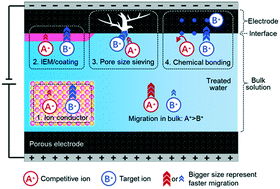Selective ion separation by capacitive deionization (CDI) based technologies: a state-of-the-art review
Abstract
Selective ion extraction from aqueous solution is of great significance for water purification as well as resource recovery. Capacitive deionization (CDI), as an emerging desalination technology, has been introduced to selectively remove target ionic contaminants in the past few years. Due to its tailorable electrode material and interface and flexible operation, CDI exhibits great superiority in regulating the ion electrosorption process thus realizing considerable selective adsorption of target contaminants. In this paper, we report an overview of the current status of selective ion adsorption in CDI systems. The mechanism of selectivity is mainly illustrated through regulating ion migration on the electrode interface or adsorption in the bulk electrode. The applied materials and strategies include (pseudo) capacitive materials, interface membranes/coatings, faradaic reactions and operation optimization. This review also discusses the prospects of selective CDI including its performance evaluation, purposes, application scope, challenges, etc., which help to inform future researchers in terms of addressing knowledge gaps in developing and applying selective CDI systems.

- This article is part of the themed collections: Best Papers 2020 – Environmental Science: Water Research & Technology and Capacitive deionisation and electrosorption 2020


 Please wait while we load your content...
Please wait while we load your content...